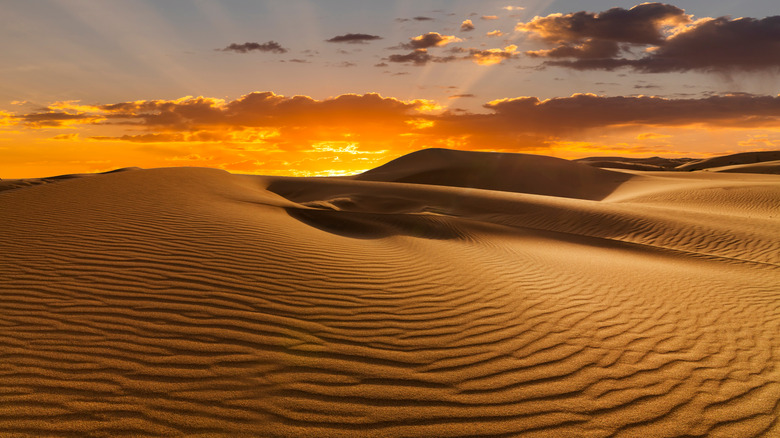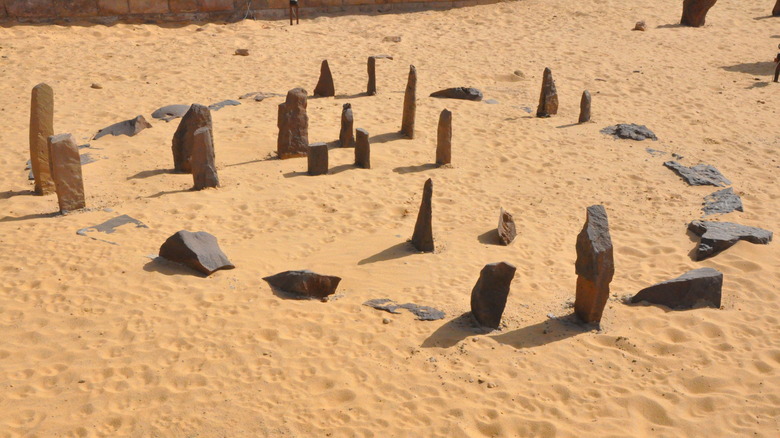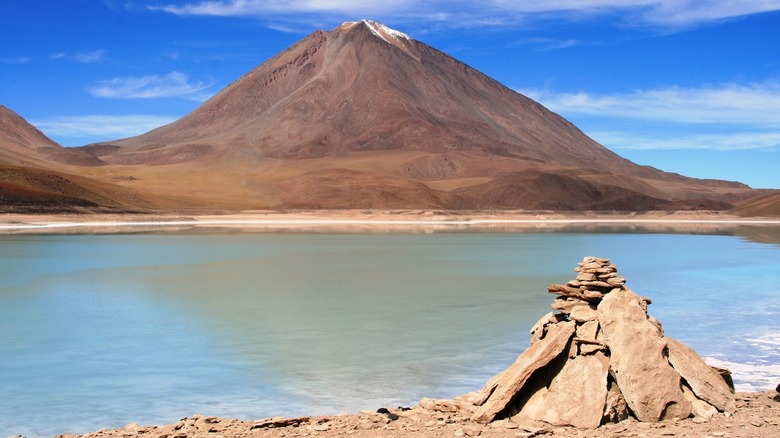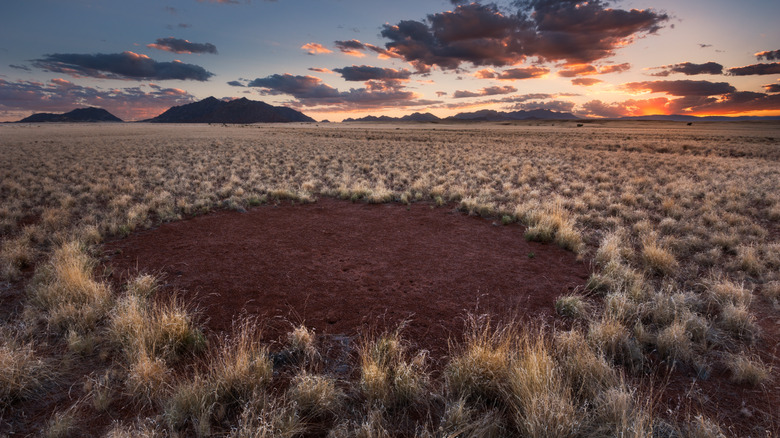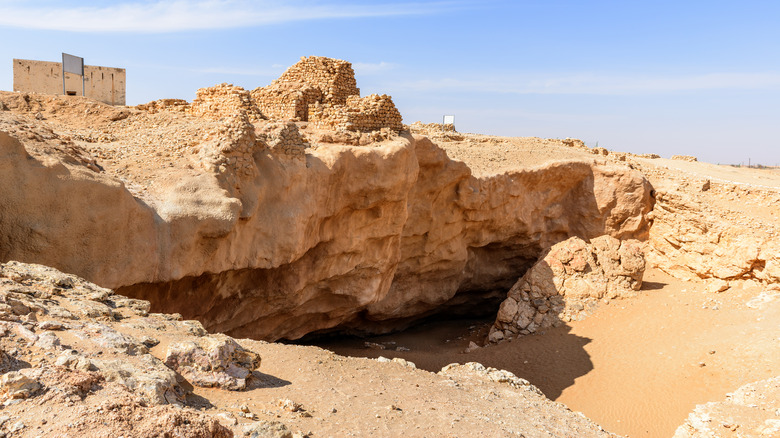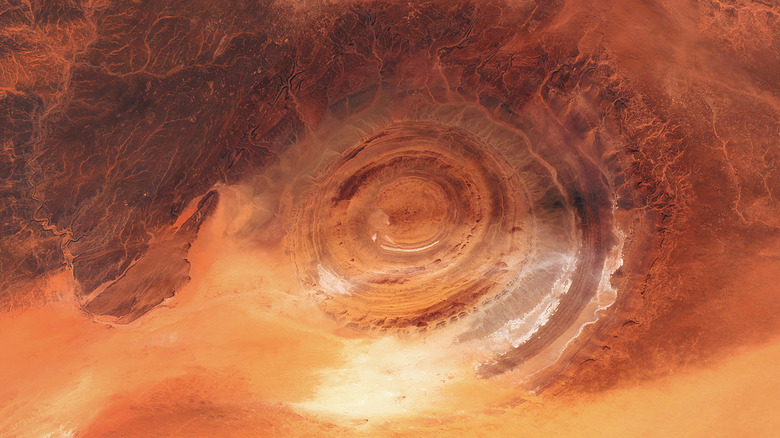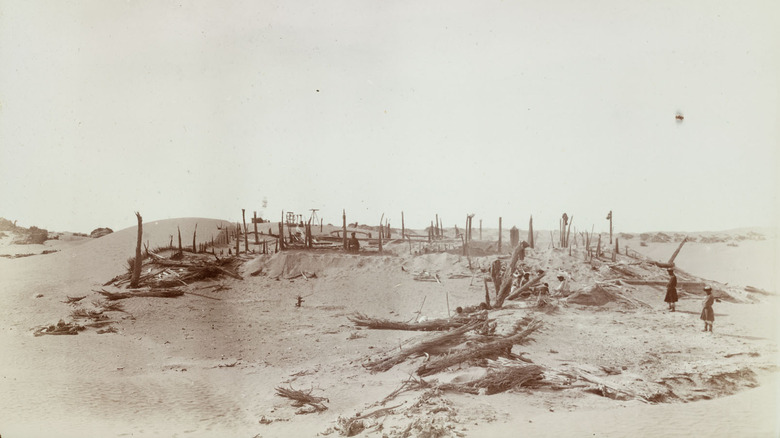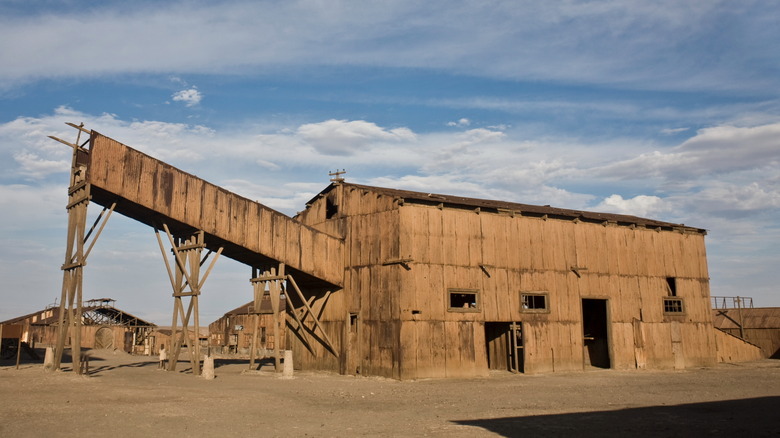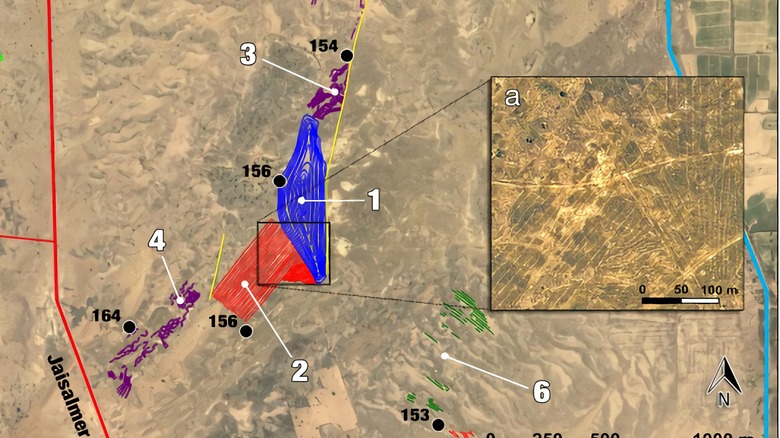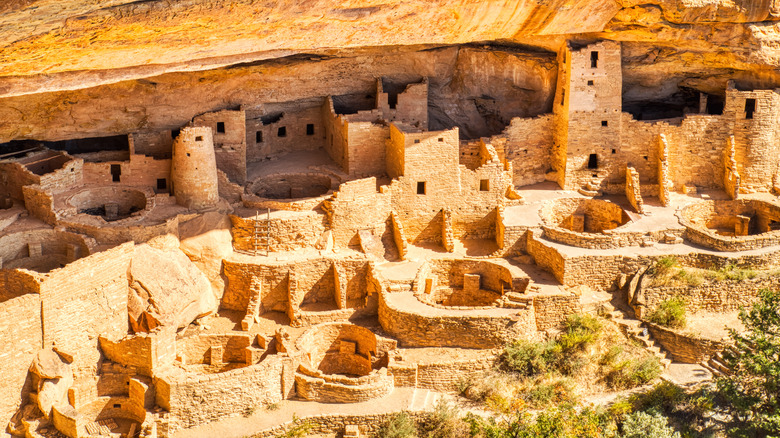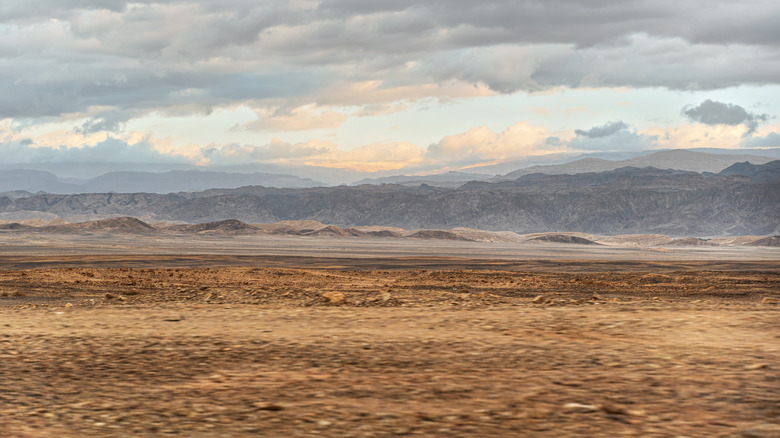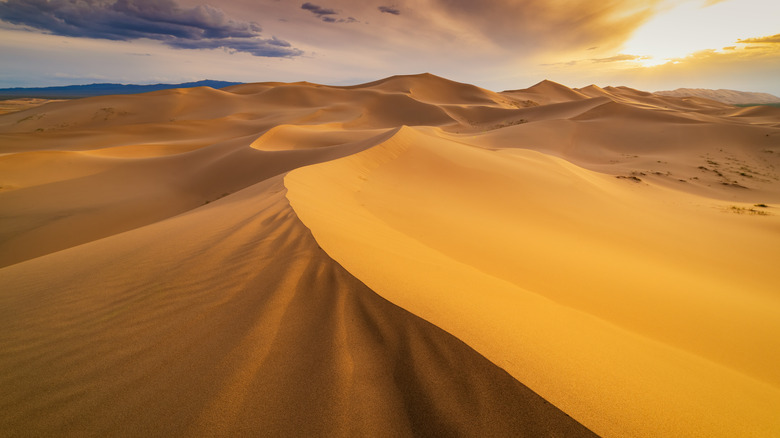Mysteries Of The Desert You've Never Heard Of
Deserts make up 33% of Earth's land surface area. Vast but not empty, hostile but not lifeless, deserts have long captured the imagination. Give it water and the desert blooms, take water away and there can soon be no trace that life was ever there.
For the ancient Egyptians, the desert was the realm of Seth, a god once considered a protecting power, but who later became an agent of chaos and destruction, and who murdered his brother, the fertility god Osiris. To Namibia's Himba people, the desert is "the land God made in anger." Across cultures, the message is clear: stay out.
But for all the seeming danger and emptiness of deserts, they are bursting with enticing mystery. They are places where mirages dance and dunes sing, where cultures can thrive but also quickly vanish. Here are just some of the mysteries that the deserts of the world guard with all the inexorable strength of a sandstorm.
Nabta Playa: The Stonehenge of the Sahara
Nabta Playa is the oldest confirmed astronomical calendar on Earth. In the scorching Sahara Desert, 60 miles west of the famous Egyptian temple of Abu Simbel, the stone circle of Nabta Playa proves that humans were looking to the stars for clues to nature's rhythms over 7,000 years ago, a full millennium before Stonehenge is thought to have been built (via Discover magazine). Interestingly, archeologists discerned the stellar alignments of Nabta Playa fairly quickly. It was other aspects of the site that mystified researchers.
As related by Discovery magazine, Nabta Playa was discovered in the 1960s, and dates to when the Sahara was green and humanity was transitioning from a Neolithic hunter-gatherer existence to one of animal domestication and rudimentary agriculture. There is strong evidence the builders of Nabta Playa were part of a cattle cult, with astronomy.com noting the presence of numerous bovine bones but no human ones.
Around 5,000 years ago, the Sahara began to dry out (per LiveScience). Forced to find new water sources, the people of Nabta Playa moved, possibly to the Nile Valley. Indeed, archeologists note that when Nabta Playa faded, Ancient Egypt rose. The prehistoric community at Nabta Playa could have been a precursor to that of Hathor, a cow goddess associated with the Milky Way who held immense power in ancient Egypt. Perhaps Nabta Playa was where Egypt began?
The saywas: an Inca power play?
Spanning the Andes from Colombia to Chile and composed of 25,000 miles of 25,000 miles of roads, bridges, tunnels, and causeways, the Qhapaq Ñan was the "interstate system" linking the Inca Empire. Its extent is all the more amazing considering the Inca never used the wheel on a practical scale like the Roman Empire; pack animals and pedestrians traversed the Qhapaq Ñan. Things get even more interesting when the roads enter the Andean deserts.
Looking like cairns, the same kinds of rock piles trekkers leave along paths, the route is interspersed with the saywas. While initial observations assumed they were markers for the Qhapaq Ñan in the desert, the Guardian explains that these pillars may be far more complex, and with a purpose far more profound.
Too carefully constructed to be simple cairns, the saywas' original purpose was lost when the Inca were annihilated by the Spanish in the 16th century, although the Guardian notes that native Felipe Guaman Poma de Ayala recorded saywas as having a theo-solar purpose — that Inti, the Sun God, would "rest" on them. Using telescope data, Dr. Cecilia Sanhueza of the Chilean Pre-Columbian Art Museum confirmed the saywas do indeed align with the sun on certain Inca holidays.
Fairy circles: an Arboreal Mystery
The Namib Desert, which runs along Africa's southwestern coast, is believed to be the oldest desert in the world. It has the highest dunes, is chock-full of diamonds, and has an ecosystem unusual in that it is based largely on coastal fogs rather than any rainfall. It is also home to one of the most niggling unknowns in botany: the fairy circles.
Characterized by a circular patch of barren ground bordered by a ring of particularly abundant grass, the BBC reports that the circles range anywhere from 7 to 49 feet across. And while scientists know their locations, the kinds of grasses involved, and even the life cycle of the rings (24 to 75 years), no one is sure how or why fairy circles form.
Radioactivity? Toxic substance build-up that the grasses grow away from? Variation of soil temperature due to desert heat? Tests have disproved all of these theories. Perhaps they're the byproduct of termites bringing nutrients underground and the grasses reaping the benefits? Negative. Was it just how the grass grew? Nope.
The latest theory, via NewScientist posits a combination as well as a clarification. Grasses competing for water explain the small circles, and termites clearing vegetation from their nests explain the larger ones. But not all scientists are convinced of the explanation.
Iram of the Pillars: The Atlantis of the Sands
"The City of Many-Columned Iram and Abdullah Son of Abi Kilabah," a tale in "One Thousand and One Nights," tells how a camel herd stumbled upon a desert ruin "built of gold and silver and inlaid with many colored jewels." Readers discover this is Iram of the Pillars, built by King Shaddad, great-great-grandson of Noah. Shaddad tried to make heaven on Earth, but God, none too keen with hubris, buried Iram and Shaddad with a sandstorm.
It's not all myth; Iram is real. It has been linked to the fabled land of Ubar and the Omanum Emporium, described by Ptolemy in the second century (via the New York Times). Also real is its unexplained disappearance, until the Space Shuttle came along.
In the early 1990s, astronauts in orbit observed ancient camel tracks converging onto one spot in western Oman, where archaeologist Juris Zurins found the sinkhole of Shisr. Featuring ruins at least 5,000 years old (via the LA Times), the site was a desert oasis fortified with a wall and watchtowers that later collapsed into the sinkhole. If Shisr is Iram of the Pillars, researchers suspect the towers are the "pillars," and that it wasn't buried but dramatically toppled in on itself. Moreover, Shisr is on the old Incense Route and would have indeed been fabulously wealthy not just for water, but trade.
The Richat structure: circles in the sand
You'd think that the origins of a geological feature so big that astronauts can pinpoint it would be easy to identify (like the Nile Delta), but the Richat Structure leaves researchers scratching their heads.
Staring up to the sky from western Africa like a gigantic bull's eye, the Richat Structure of Mauritania is a collection of concentric rings 28 miles across in the Sahara Desert. The astonishing symmetry of the Richat has led to a plethora of ocular nicknames like "the Eye of the Sahara" and the "Eye of Africa." When a naturally formed ring on Earth's crust is found, the go-to explanations that scientists favor are a meteor crater or the remains of a volcano. But the Richat is neither; it has none of the rocks typical of an impact, and its center is made of breccia, a sedimentary rock incompatible with a volcanic throat.
Instead, geologists currently theorize that the Richat Structure is an eroded domed anticline. The Geology Page describes such a feature as "an area of the subsurface where the strata have been pushed into forming a domed shape." In the case of the Richat, the idea goes that the dome pushed up to the surface and weathering wore it down, exposing its constituent layers as rings. A more extensive survey is needed, but the remoteness of the Richat Structure and the hostile Sahara make that unlikely.
Niya: A prosperous kingdom vanishes
Angkor, the Maya, Cahokia — all these civilizations flourished until, one day, they didn't. Now add Niya to that list.
Located on the Silk Road in the deserts of modern China, the oasis of Niya could not have been more cosmopolitan. The Washington Post notes that from the west came Greek and Roman settlers, from the south Buddhist scholars, and from the east traders with all the luxuries of China. A hybridized culture emerged, and by the Han Empire, Niya was where worlds met. But there is also a folktale of a Niya king lusting for his daughter and God destroying the city for as punishment, and by the 7th century, the city was lost.
However, the destruction of Niya may have less to do with creepy family dynamics than geography. Modern excavations at the site only began in the 1980s (via ChinaDaily), but it is clear that Niya depended on its namesake river for life. Without it, the city faced the wrath of the Taklamakan Desert. Today, the river is nowhere near the ruins, which sit well within the desert's parched borders. Archeologists found that the inhabitants seemed to have left in a panic. Was it war or thirst?
Excavations are ongoing, and Niya left a huge repository of writing (the Washington Post notes ancient letters still unopened in situ). Science may discover why Niya vanished from Niya itself.
The Atacama Nitrates: a watery mystery in the desert
How can a mineral associated with water appear in a desert so dry it can go for years without rain? The mineral is sodium nitrate, and the desert is the Atacama in northern Chile, which is so hostile that NASA considers it a proxy for Mars. From a geologist's perspective, that mineral should not be in that desert.
LiveScience explains that sodium nitrate is plentiful in the atmosphere, but not the ground; the deposits could have built up over time by being blown in from the Pacific in the form of fog or very infrequent rains, but this is unlikely — the nitrates are behind the Chilean Coastal Ranges mountains (out of reach of sea fog), and the Andean high pressure system keeps rain out to sea. A 2011 study speculates that the nitrates resulted from microbiological or photochemical reactions.
The most recent theory is that the nitrates are the result of ancient, mineral-saturated groundwater and the rise of the Andes 20 million years ago, according to LiveScience. With the Coastal Ranges acting as a dam, the groundwater was pushed to the surface and the Atacama, a result of the Andes' rain shadow, evaporated it, leaving the nitrates behind. This formed a nitrate "belt" 435 miles long and 12 miles wide. Whole towns lived and died to mine this "white gold" for industries ranging from glass to explosives, according to Atlas Obscura.
Thar Desert geoglyphs: young and really big
In 2021, Carlo and Yohann Oetheimer published a paper on a series of newly identified geoglyphs — patterns artificially etched into the ground — near the Indian village of Boha in the Thar Desert.
Named for the village, Boha 1, a giant asymmetrical spiral, is made from a single line 792 yards long by 220 yards and running 7.5 miles. Boha 2 is a serpent-like image marked by a 6.8-mile line, and Boha 3 is a series of wavy lines 30 miles long, but it could have originally been 50 miles long. AncientOrigins notes the geoglyphs required serious math and planimetry skills and could be the largest art ever created by humans, easily dwarfing the famous Nazca Lines. Moreover, these patterns are recent — the Oetheimers estimate an age of 150 years, placing their date of origin around 1871.
It's so far unknown who carved them or why. Like the Nazca Lines, the Bohas can be seen only from above, but the Wright Brothers didn't take flight until 1903, and they were on the other side of the planet. AncientOrigins notes the geoglyphs are in an area dotted with Hindu memorial stones, about which little is known. It is possible that the Bohas have a religious or sacred purpose. Only further study will tell.
The Antarctic gravity anomaly: planet killer
Not all deserts are hot and sandy. Along with being the highest, coldest, windiest, and brightest of the seven continents (via NASA), Antarctica is also the driest. According to World Atlas, the South Pole receives less than 3.94 inches of precipitation annually. But throw in millions of years of sub-freezing temperatures and you have a continent-wide ice sheet 3 miles thick.
It is so big — 300 miles wide — that it throws off gravity. Ice prevents direct observation, but what NASA scientists call the Antarctic gravity anomaly is a suspected meteor crater. It's thought that the meteor's impact thinned the crust, leaving less mass to create an even gravitational field. If it is a crater, the meteorite was huge, around 30 miles in diameter (five times larger than the dinosaur-killing Chicxulub meteor). It is also ancient, at around 260 million years.
Around that time, the greatest die-off Earth has experienced began. The Permian-Triassic Extinction, aka "the Great Dying," killed 70% of all land animals and 96% of all oceanic species. Paleontologists suspect the cause is a 300,000-year volcanic event covering 11 million square miles in modern Siberia (via Elsevier), and the anomaly could be the trigger. As reported at DailyGalaxy, NASA believes the Antarctic meteor impact sent a straight-line shockwave through Earth like a Newton's Cradle, resulting in a cyclopean wave of magma hurtling to the surface in Siberia.
The fall of the Anasazi: history repeating
The people known as the Anasazi are technically called the Ancestral Puebloans. According to the American Pueblo Cultural Center, the word "anasazi" means "ancient enemies" in Navajo, a language whose people have no links to the Puebloans (and is pejorative). Starting in the 850s, the Ancestral Puebloans created one of North America's most brilliant civilizations, constructing cities such as Pueblo Bonito in New Mexico and cliff dwellings like Mesa Verde in Colorado. But by 1300, they were gone.
Lack of written records requires educated guesswork: Archeologists know that by 1300, Ancestral Puebloan sites were abandoned, and a study by Rebecca Forsman of California State University notes clear signs of war and migration out of Puebloan territory — but this is effect, not cause. Past theories include poor land-use and deforestation (via AncientOrigins), but Forsman posits a more topical reason: megadrought.
Using dendrochronology, Forsman discovered that in 1130, a drought hit the Puebloan region lasting 50 years. For a Stone Age farming culture, this was an apocalypse in slo-mo, and it goes a long way in explaining creeping signs of violence and migration before population and cultural collapse.
It is also a sobering reminder that the American Southwest is in another megadrought, one the Guardian calls the worst in 1,200 years. In other words, since the Ancestral Puebloans vanished.
The big circles: mystery in the Middle East
The Middle East is home to fascinating archeological discoveries and more than a few historical sites with mysterious origins. Even the simplest-looking ones can be deceptively cryptic, like the Big Circles.
Dotting a swath of real estate running from Jordan to Syria and Turkey, Smithsonian Magazine reports the Big Circles were first noticed in the 1920s by pilots. The 12 nearly circular structures range from 720 feet to over 1,200 feet across, are remote, and have no entry points, according to LiveScience. Because Roman roads bisect two, archeologists are confident the circles are at least 2,000 years old (the time when Romans pushed into the region). However, it's unknown who built the Big Circles and why.
The Middle East is home to plenty of previously mysterious walls in the middle of nowhere, but many of those were found to be ancient funnels for trapping game, according to Atlas Obscura. The walls of the Big Circles are too low to have made them useful as animal pens. LiveScience reports that the Big Circles only regained the attention of scientists in the last few decades, and that warfare and development threaten the ancient monuments. In fact two, in Jordan and Syria, have already been completely destroyed.
Singing dunes: mystery solved?
Arguably the most famous and long-lived of all desert mysteries is of dunes that sing. Legends and mythology from across Earth's sandy deserts, from North America to Central Asia, speak of dunes that "hum" or "boom" or "rumble" with no obvious origin. To Arabs, the cause was malevolent spirits known as the djinn; in China, folklore states one particular singing dune contained a buried city lamenting its fate. But the truth is even more fascinating.
As reported by National Geographic and LiveScience, it's all about size and movement. A team of French researchers found that either by wind or footfalls, sand sent slipping down a dune whose grains are 150 to 300 microns across creates a distinctive hum. This study bolsters an earlier finding that a dune slope with an angle of 35 degrees is optimal, and the sand must also be sufficiently dry. For smaller dunes, the grains must also be hot and the wind still. And this is no faint sound; LiveScience reports a singing dune can be heard 6 miles away.
Yet at least one part of the mystery lingers; researchers have yet to identify how a small slippage of sand on one part of a dune makes the whole structure resonate. Scientists speculate that once the sand starts going, it creates a domino effect that echos back and forth between grains throughout the dune. Mysteries die a slow death, it seems.
